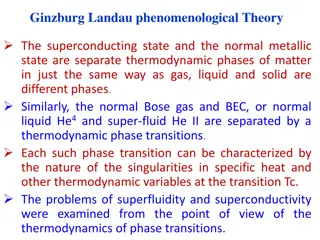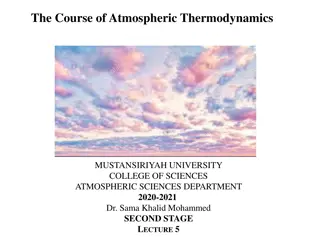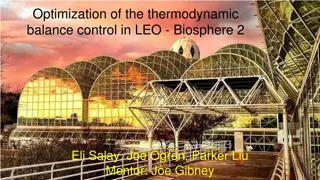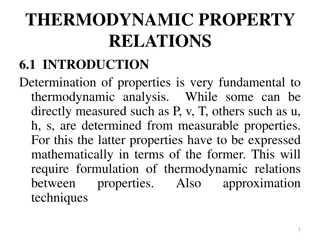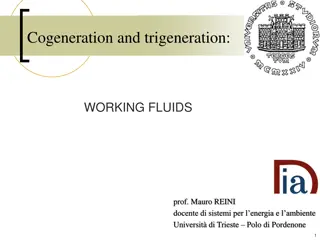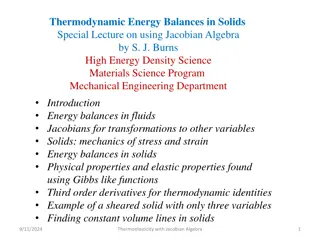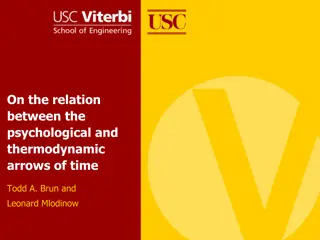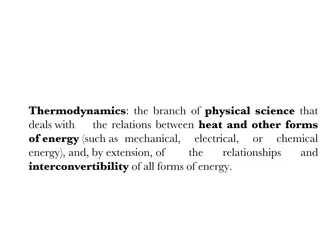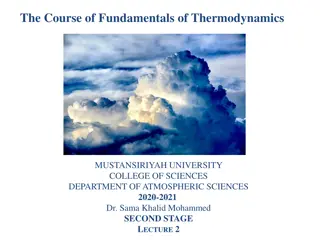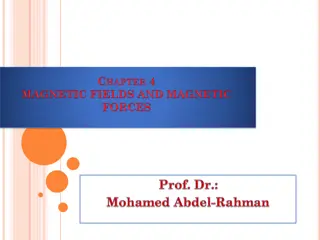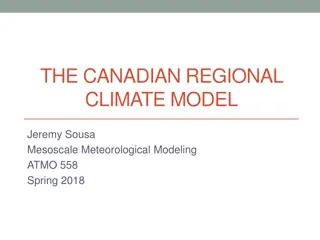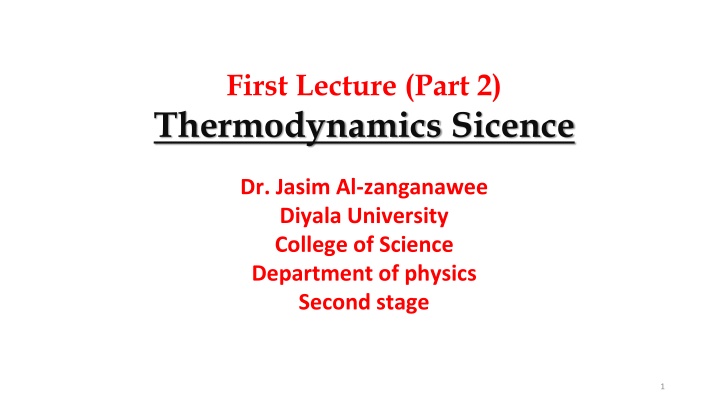
Thermodynamic Processes in Science - Lecture Insights
Explore the world of thermodynamics with Dr. Jasim Al-zanganawee at Diyala University, covering topics like thermodynamic equilibria, processes, and cycles. Learn about isothermal, adiabatic, isochoric, and isobaric processes, as well as reversible and irreversible processes. Gain a deeper understanding of thermal equilibrium, mechanical equilibrium, and more in this comprehensive lecture series.
Uploaded on | 2 Views
Download Presentation

Please find below an Image/Link to download the presentation.
The content on the website is provided AS IS for your information and personal use only. It may not be sold, licensed, or shared on other websites without obtaining consent from the author. If you encounter any issues during the download, it is possible that the publisher has removed the file from their server.
You are allowed to download the files provided on this website for personal or commercial use, subject to the condition that they are used lawfully. All files are the property of their respective owners.
The content on the website is provided AS IS for your information and personal use only. It may not be sold, licensed, or shared on other websites without obtaining consent from the author.
E N D
Presentation Transcript
First Lecture (Part 2) Thermodynamics Sicence Dr. Jasim Al-zanganawee Diyala University College of Science Department of physics Second stage 1
In the end of this lessen, you will be able to: 1.Describe three types of thermodynamic equilibria: thermal equilibrium, mechanical equilibrium. 2.State zeroth law of thermodynamics and give its application. 3.Discriminate between isobaric, isothermal, isochoric and adiabatic processes. equilibrium and chemical
10. Path And Process Q: Define thermodynamic path, process and cycles - Path of the system: The series of states passed through during a change of state is called the path of the system. - Process: The mode in which the change of state of a system takes place is termed as process. In the other words, When state of system changes then process is said to occur. -The first and last state of process are called initial and final state respectively Process 3
- Process give us the path by which system changes from one state to other - There are certain processes in which particular state variable is kept constant 4
11. Types of Process 1. Isothermal Process(T): It is defined as the process in which temperature of system remains constant. Heat can flow from system to surrounding and vice versa in order to keep the temperature constant. 5
10. Types of Process (contd) 2. Adiabatic Process: The system does not exchange heatwith the surrounding System is completely insulated from surrounding 3. Isochoric Process (V): Volume of system remains constant during the process 4. Isobaric Process (p): Here pressure of the system remains constant during the process Types of Process 6
Process (contd) Q: Explain the concept of cyclic process. Cyclic Process: Here the system undergoes series of changes and finally returns to its initial state 7
Reversible and Irreversible Processes Q: What is an reversible and irreversible processes? Give an examples of both processes? 1.Reversible Process: Such a process is carried out infintesimally slowly so that all changes occuring in the direct process can be reversed and the system and the surrounding remain in state of equilibrium It is an ideal process and cannot be realized in actual process. 2. Irreversible process: Change is brought about rapidly and the system does not attain equilibrium. The force which drives the reactants towards products is greater than opposing force which is to carry reverse process. 8
Spontaneous and Non Spontaneous processes 1. Spontaneous process: It may also be defined as the process which can take place by itself or initiation Which take place by itself Evaporation of water in open vessel Dissolution of salt in water Flow of water down a hill 2. Non Spontaneous Process: It is the process which cannot take place by itself or initiation Examples: Flow of heat from cold body to hot body Flow of water up the hill Dissolution of sand in water 9
8. Thermodynamics Equilibrium Q: Define thermodynamic equilibrium system Thermodynamics Equilibrium A system is said to be in thermodynamic equilibrium if it maintains a. Thermal Equilibrium ( Equality of Temperature ) b. Mechanical Equilibrium ( Equality of Forces / Pressure ) c. Chemical Equilibrium ( Equality of Chemical Potential ) 10
Definition Of Temperature and Zeroth Law Of Thermodynamics Temperature is a property of a system which determines the degree of hotness. Obviously, it is a relative term. Example g: A hot cup of coffee is at a higher temperature than a block of ice. On the other hand, ice is hotter than liquid hydrogen. Two systems are said to be equal in temperature, when there is no change in their respective observable properties when they are brought together. In other words, when two systems are at the same temperature they are in thermal equilibrium (They will not exchange heat). 12
Zeroth Law If two systems (say A and B) are in thermal equilibrium with a third system (say C) separately (that is A and C are in thermal equilibrium; B and C are in thermal equilibrium) then they are in thermal equilibrium themselves (that is A and B will be in thermal equilibrium Q: State Zeroth law of thermodynamics. Ans. It states if the bodies A and B are in thermal equilibrium with a third body C separately, then the two bodies A and B shall also be in thermal equilibrium with each other. 13
Explanation of Zeroth Law Let us say TA,TB and TC are the temperatures of A,B and C respectively. A and c are in thermal equilibrium. Ta= tc B and C are in thermal equilibrium. Tb= tc Consequence of of 0 th law A and B will also be in 14TA=TB Looks very logical All temperature measurements are based on this LAW. Q: How Zeroth law of thermodynamics is applied in thermometry? Ans. Zeroth law states that if two systems are each in thermal equilibrium with a third system separately then two systems are also in thermal equilibrium with each other It provide the basis for the measurement of temperature of a system. 14

